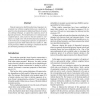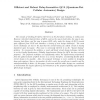171 search results - page 16 / 35 » On the Power of Tree-Walking Automata |
CADE
2001
Springer
14 years 2 months ago
2001
Springer
The dependency pair method of Arts and Giesl is the most powerful technique for proving termination of term rewrite systems automatically. We show that the method can be improved b...
LICS
1997
IEEE
14 years 1 months ago
1997
IEEE
Fixpoint expressions built from functional signatures interpreted over arbitrary complete lattices are considered. A generic notionof automatonis defined and shown, by means of a ...
MST
2008
13 years 9 months ago
2008
Formal power series over non-commuting variables have been investigated as representations of the behavior of automata with multiplicities. Here we introduce and investigate the co...
DFT
2006
IEEE
14 years 1 months ago
2006
IEEE
The concept of clocking for QCA, referred to as the four-phase clocking, is widely used. However, inherited characteristics of QCA, such as the way to hold state, the way to synch...
AAAI
2008
14 years 4 days ago
2008
One potentially cost-effective approach to harvesting solar power from space is the use of thousands of individual robots moving in formation, each with a piece of solar panel att...


